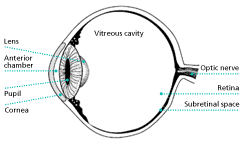

The eye is an essential organ for survival – for humans, and for the vast majority of other vertebrates. Like other vital organs and tissues, it is vulnerable to a variety of external and internal pathogens that can abolish its critical function and threaten the host's survival. To avoid this catastrophe, evolution has provided vertebrates with a wide spectrum of general and local defense mechanisms designed to neutralize the virulence of pathogens. The fact that the spectrum of defense mechanisms is wide reflects, on the one hand, the extreme diversity of pathogens, each with a unique 'spin' on virulence strategies, and, on the other, the unique vulnerability of different organs and tissues to the distinct virulence strategies of different organisms. Thus, the protection against injury from pathogens that is conferred at any particular site in the body is both distinctive and appropriate for the range of potential pathogens and for the physiologic functions of that site. The term 'regional immunity' has been used to identify this dimension of immune protection against pathogens. The eye is a good example of an organ that possesses 'regional immunity', and immune privilege in the eye is the experimental and clinical expression of this concept.
Especially for humans, precise vision of detailed images is vital for survival. This property depends upon absolute integrity of the so-called visual axis: the structures of the eye that permit light to enter the organ, and encourage and focus light images onto the neuronal retina (fig. 1). These structures include the ocular surface (tear film, cornea), the anterior chamber (aqueous humor) and pupil of the iris, the lens, the vitreous body, and the layers of retina immediately anterior to the photoreceptor cells. Each of these structures is uniquely endowed with the property of transmitting light with a minimum of distortion and diffraction. The precise anatomic relationships of these structures are critical to achieve a focused image at the level of the retina. Even very minor deviations (millimeters or less) in the anatomic integrity of the visual axis can result in impaired vision.
Not surprisingly, inflammation, if it occurs within the eye, is a profound threat to vision. In an inflamed eye, light transmission through the visual axis can be impeded and diffracted by leukocytes and plasma proteins, and the visual axis itself can be distorted, causing the focused light image to fall away from the photoreceptor outer segments. Thus, the dilemma! Inflammation is one of the most important pathways by which immune mechanisms protect a tissue against pathogens. It is this dilemma – the need for immune protection, and the vulnerability to the consequences of inflammation – that lies at the heart of immune privilege in the eye. Through adaptation, evolution has devised a special form of immune protection (we call it immune privilege) that enables the eye to resist the vast majority of pathogens by using processes largely devoid of inflammation, thereby avoiding loss of vision. We should remember that adaptations of this type represent biologic compromises, and in the case of ocular immune privilege, the compromise renders the eye vulnerable to those organisms whose pathogenicity and virulence can only be eliminated with the aid of overt inflammation.
The Eye's Dilemma
Immune Privilege
Anterior Chamber of the Eye as an Immune- Privileged Site
Inflammation of Relation to Innate and Adaptive Immune Responses
Ocular Factors That Promote Immune Tolerance of Eye-Derived Antigens
Factors That Modify Expression of Ocular Adaptive Immunity
Innate Immune Privilege in the Eye
Factors That Modify Expression of Innate Ocular Immunity
Clinical Meaning of Ocular Immune Privilege
Selected Reading
Biography
>> next
